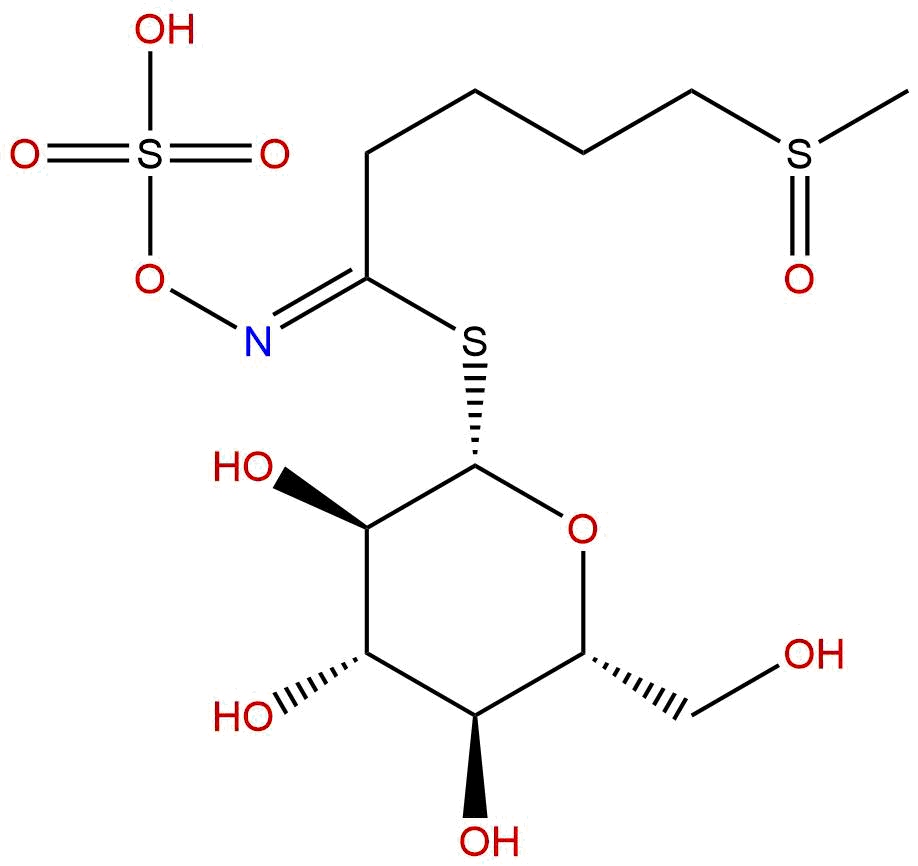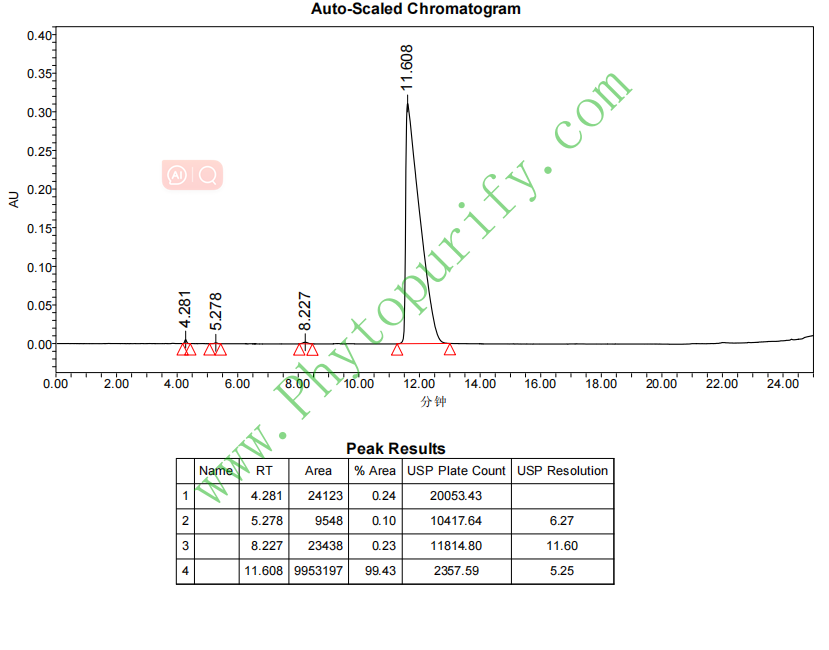
GlucoraphaninCAS No.:21414-41-5
|
||||||||||
 |
|
|
||||||||

| Catalogue No.: | BP0676 |
| Formula: | C12H23NO10S3 |
| Mol Weight: | 437.51 |
Product name: Glucoraphanin
Synonym name: 4-(Methylsulfinyl)butyl glucosinolate
Catalogue No.: BP0676
Cas No.: 21414-41-5
Formula: C12H23NO10S3
Mol Weight: 437.51
Botanical Source:
Physical Description:
Type of Compound: Aliphatics
Purity: 95%~99%
Analysis Method: HPLC-DAD or/and HPLC-ELSD
Identification Method: Mass, NMR
Packing: Brown vial or HDPE plastic bottle
Storage: Store in a well closed container, protected from air and light. Put into refrigerate or freeze for long term storage.
The product could be supplied from milligrams to grams
Inquire for bulk scale.
For Reference Standard and R&D, Not for Human Use Directly.
Description:
Glucoraphanin, the bioprecursor of the widely extolled chemopreventive agent sulforaphane found in broccoli, it has antioxidant activity, it induces phase-I xenobiotic metabolizing enzymes and increases free radical generation in rat liver. Glucoraphanin can ameliorates obesity and insulin resistance through adipose tissue browning and reduction of metabolic endotoxemia in mice. Glucoraphanin and Glucoerucin effectively act as antagonists for the aryl hydrocarbon receptor, and this may contribute to their established chemoprevention potency.
References:
Asian Pac J Cancer Prev. 2015;16(14):5801-5.
Naturally-Occurring Glucosinolates, Glucoraphanin and Glucoerucin, are Antagonists to Aryl Hydrocarbon Receptor as Their Chemopreventive Potency.
As a cytosolic transcription factor, the aryl hydrocarbon (Ah) receptor is involved in several patho- physiological events leading to immunosuppression and cancer; hence antagonists of the Ah receptor may possess chemoprevention properties.
METHODS AND RESULTS:
It is known to modulate carcinogen-metabolising enzymes, for instance the CYP1 family of cytochromes P450 and quinone reductase, both important in the biotransformation of many chemical carcinogens via regulating phase I and phase II enzyme systems. Utilising chemically-activated luciferase expression (CALUX) assay it was revealed that intact glucosinolates, Glucoraphanin and glucoerucin, isolated from Brassica oleracea L. var. acephala sabellica and Eruca sativa ripe seeds, respectively, are such antagonists. Both glucosinolates were poor ligands for the Ah receptor; however, they effectively antagonised activation of the receptor by the avid ligand benzo[a]pyrene. Indeed, intact glucosinolate Glucoraphanin was a more potent antagonist to the receptor than glucoerucin.
CONCLUSIONS:
It can be concluded that both glucosinolates effectively act as antagonists for the Ah receptor, and this may contribute to their established chemoprevention potency.
Diabetes. 2017 May;66(5):1222-1236.
Glucoraphanin Ameliorates Obesity and Insulin Resistance Through Adipose Tissue Browning and Reduction of Metabolic Endotoxemia in Mice.
Low-grade sustained inflammation links obesity to insulin resistance and nonalcoholic fatty liver disease (NAFLD). However, therapeutic approaches to improve systemic energy balance and chronic inflammation in obesity are limited. Pharmacological activation of nuclear factor (erythroid-derived 2)-like 2 (Nrf2) alleviates obesity and insulin resistance in mice; however, Nrf2 inducers are not clinically available owing to safety concerns.
METHODS AND RESULTS:
Thus, we examined whether dietary Glucoraphanin, a stable precursor of the Nrf2 inducer sulforaphane, ameliorates systemic energy balance, chronic inflammation, insulin resistance, and NAFLD in high-fat diet (HFD)-fed mice. Glucoraphanin supplementation attenuated weight gain, decreased hepatic steatosis, and improved glucose tolerance and insulin sensitivity in HFD-fed wild-type mice but not in HFD-fed Nrf2 knockout mice. Compared with vehicle-treated controls, Glucoraphanin-treated HFD-fed mice had lower plasma lipopolysaccharide levels and decreased relative abundance of the gram-negative bacteria family Desulfovibrionaceae in their gut microbiomes. In HFD-fed mice, Glucoraphanin increased energy expenditure and the protein expression of uncoupling protein 1 (Ucp1) in inguinal and epididymal adipose depots. Additionally, in this group, Glucoraphanin attenuated hepatic lipogenic gene expression, lipid peroxidation, classically activated M1-like macrophage accumulation, and inflammatory signaling pathways.
CONCLUSIONS:
By promoting fat browning, limiting metabolic endotoxemia-related chronic inflammation, and modulating redox stress, Glucoraphanin may mitigate obesity, insulin resistance, and NAFLD.
HPLC of Glucoraphanin
